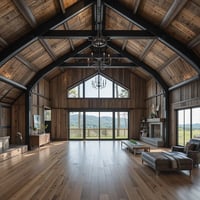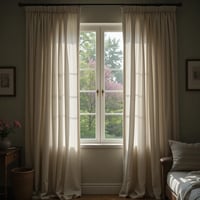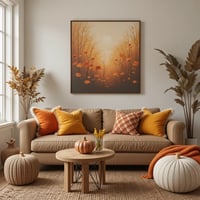You know that feeling when you drive past a gorgeous barn house and think, "Wow, I could totally...
Midcentury Modern Is Back—Here’s How to Make It Work in Your Home

While midcentury modern design is hardly the sole style to have seen a revival, it's certainly one of the most enduring. With clean lines, warm wood tones, and the perfect balance of form and function, it's little wonder that this style continues to dominate interior design trends. Whether you’re drawn to the charm of vintage furniture or love the simplicity of clean, uncluttered spaces, midcentury modern offers a timeless appeal that fits effortlessly into contemporary homes.
Disclosure: This post contains affiliate links which means I may receive a small commission at no extra cost to you
So, how do you bring this iconic style into your home without it feeling like a time capsule? The secret is pairing classic midcentury staples with contemporary elements to create a space that's not just modern but also livable. We're decoding everything from statement-making furniture scores to subtle decorative flourishes in order to run through the best ways to go midcentury modern without sacrificing personality or comfort. Let's get started!
30. Incorporate Iconic Furniture Pieces

Midcentury modern is known for its statement furniture, like the Eames lounge chair, the Saarinen tulip table, and sleek, low-profile sofas. Even one standout piece can set the tone for the entire room.
29. Embrace Warm Wood Tones

Rich woods like teak, walnut, and rosewood are staples of midcentury design. Look for furniture, paneling, or even decor accents in these warm hues to add an authentic touch.
28. Keep It Clean and Functional

Midcentury modern spaces prioritize function over excess. Choose furniture with sleek lines, tapered legs, and minimal ornamentation to keep the look clean and stylish.
27. Use a Retro-Inspired Color Palette

Think warm oranges, mustard yellows, avocado greens, and deep blues. These classic hues can be used on walls, upholstery, or accessories to instantly evoke a midcentury feel.
26. Add Geometric and Abstract Patterns

Midcentury modern design often features bold geometric prints in rugs, wallpaper, and textiles. Opt for eye-catching patterns in a vintage-inspired color scheme to make a statement.
25. Go for Statement Lighting

Sputnik chandeliers, globe pendants, and arc floor lamps are all midcentury staples. These lighting choices add both function and a sculptural element to your space.
24. Opt for Low, Streamlined Seating

Sofas and chairs from this era are typically low to the ground with clean, angular lines. Look for pieces with button tufting or sleek leather upholstery for a vintage vibe.
23. Mix Vintage and Modern Pieces

To keep your space from feeling like a museum, mix authentic vintage finds with modern decor. A midcentury dresser can pair beautifully with contemporary artwork or accessories.
22. Introduce Natural Materials

Midcentury homes often feature organic materials like stone, wood, and leather. Incorporating these elements through furniture, countertops, or decor will enhance the overall aesthetic.
21. Bring in Midcentury Artwork

Abstract, minimalist, and atomic-style artwork fits perfectly in a midcentury space. Look for framed prints or even original pieces that capture the movement’s artistic flair.
20. Choose Classic Midcentury Accessories

Vintage-inspired clocks, sculptural vases, and sunburst mirrors are all hallmarks of midcentury decor. These small additions can make a big impact in tying the look together.
19. Go for Open Shelving

Instead of bulky cabinets, opt for open shelving units to display books, ceramics, and decorative pieces. This keeps the space light and airy while maintaining functionality.
18. Layer in Textures

Midcentury modern isn’t just about sleek surfaces—it also embraces texture. Mix in woven rugs, leather furniture, and knobby upholstery to add depth and warmth.
17. Incorporate Indoor Plants

Nothing brings midcentury interiors to life like lush greenery. Opt for plants like fiddle-leaf figs, snake plants, or rubber trees in stylish ceramic or wooden planters.
16. Focus on Large Windows and Natural Light

Many midcentury homes were designed with an emphasis on indoor-outdoor living. If possible, highlight large windows, remove heavy drapes, and let in as much natural light as possible.
15. Create a Conversation Pit

A true midcentury modern statement, conversation pits were built-in, sunken seating areas designed for socializing. While a full renovation may not be realistic, you can mimic the concept with a cozy sectional arranged in a circular or semi-circular layout.
14. Incorporate Sliding Room Dividers

Instead of traditional walls, midcentury homes often used open shelving or sliding wood or glass dividers to separate spaces while maintaining an airy feel. You can recreate this look with a stylish, retro-inspired partition.
13. Opt for a Starburst Fireplace

Midcentury fireplaces often featured striking, asymmetrical designs or floor-to-ceiling brick or stone elements. If you can’t renovate, a starburst-style metal fireplace screen can add a similar flair.
12. Install Terrazzo Flooring or Accents

Terrazzo—composite flooring made from chips of marble, quartz, or glass—was huge in midcentury homes. If redoing floors isn’t an option, consider terrazzo-inspired tiles, countertops, or decor pieces.
11. Add a Built-In Bar or Credenza

Entertaining was a big part of midcentury culture, and built-in bars or sleek, wooden credenzas were often centerpieces of living rooms. A vintage bar cart or sideboard can easily capture this retro-chic vibe.
10. Use Atomic-Inspired Hardware and Fixtures

Drawer pulls, cabinet knobs, and door handles with atomic-age shapes (starbursts, boomerangs, or sleek metallics) are small details that can make a huge impact in a midcentury space.
9. Frame Floor-to-Ceiling Windows with Simple Treatments

Midcentury homes emphasized natural light and connection to the outdoors. If you have large windows, opt for simple, sheer curtains or minimal roller shades to maintain the clean aesthetic.
8. Add a Retro-Inspired Vinyl or Record Player Setup

Music was a big part of midcentury culture, and a vintage-inspired record player with a collection of vinyl displayed on an open shelf can add an authentic nostalgic touch.
7. Choose Hairpin-Leg Furniture

Whether it’s coffee tables, nightstands, or even desks, hairpin legs are a signature midcentury design element. They add a lightweight, minimalist look to furniture without overwhelming the space.
6. Create a Bold, Statement Ceiling

Midcentury homes often featured ceilings with exposed wood beams or even painted, textured surfaces. Adding wood paneling, geometric wallpaper, or a pop of color to the ceiling can instantly elevate your space.
5. Incorporate Sculptural Seating

Beyond standard sofas and chairs, midcentury design embraced unconventional seating like egg chairs, ball chairs, and curved lounges. Adding one of these statement pieces instantly enhances the vintage aesthetic.
4. Use Brick or Stone Accent Walls

Natural materials were a hallmark of midcentury design, and an exposed brick or stone wall adds warmth and texture. If you don’t have an existing one, faux brick or peel-and-stick stone panels can create a similar effect.
3. Extend the Look Outdoors

Midcentury modern style isn’t just for interiors! A retro patio setup with wire-frame chairs, a butterfly lounge, a fire pit, and globe string lights can extend the aesthetic into your backyard or balcony.
2. Go for Floating or Cantilevered Furniture

Midcentury modern design often played with gravity-defying elements like floating shelves, cantilevered sofas, and wall-mounted credenzas. These pieces add a sleek, airy feel while maximizing floor space.
1. Experiment with Wood Slat Walls

Vertical or horizontal wood slats were commonly used in midcentury homes as accent walls, room dividers, or even on ceilings. Adding a wood slat feature brings warmth, texture, and a touch of retro sophistication to any space.





